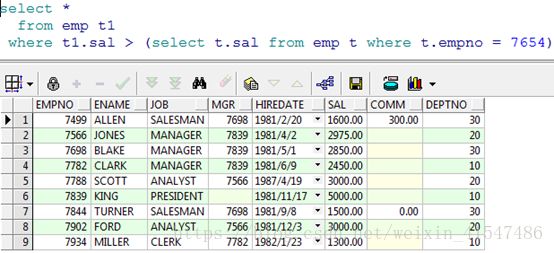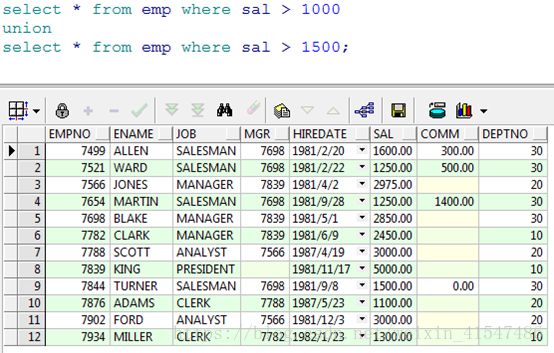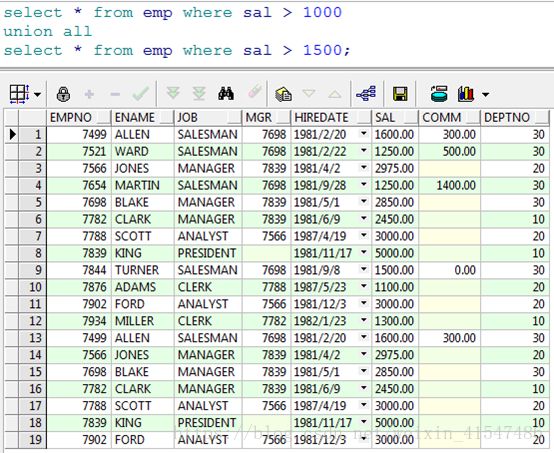- MySQl篇(SQL - 基本介绍)(持续更新迭代)
wclass-zhengge
mysqlsql数据库
目录一、简介二、SQL方言(分页查询为例)1.简介2.SQL方言大比拼2.1.Oracle2.1.1.使用ROWNUM实现分页查询2.1.2.使用ROW_NUMBER()实现分页查询2.2.MySQL2.3.PostgreSQL三、语法规范四、注释五、MySQL脚本中的标点符号一、简介1、SQL是结构化查询语言(StructureQueryLanguage),专门用来操作/访问关系型数据库的通用语
- 梧桐数据库(WuTongDB):数据库技术中都有哪些常见的优化器
鲁鲁517
梧桐数据库梧桐数据库
以下是一些常见的数据库优化器:1.CBO(Cost-BasedOptimizer)应用场景:广泛应用于关系型数据库中,如Oracle、PostgreSQL、MySQL等。工作原理:通过计算不同执行计划的代价(如CPU、I/O等资源消耗),选择最低代价的执行计划。代表数据库:Oracle、PostgreSQL、MySQL。特点:CBO使用统计信息(如表大小、索引分布)来评估查询的代价。2.RBO(R
- 解决mysql漏洞 Oracle MySQL Server远程安全漏洞(CVE-2015-0411)
dieweidong5625
数据库运维java
有时候会检测到服务器有很多漏洞,而大部分漏洞都是由于服务的版本过低的原因,因为官网出现漏洞就会发布新版本来修复这个漏洞,所以一般情况下,我们只需要对相应的软件包进行升级到安全版本即可。通过查阅官网信息,OracleMySQLServer远程安全漏洞(CVE-2015-0411),受影响系统:OracleMySQLServer/usr/databases.sql//先备份原有所有数据,防止数据丢失。
- MySQL内存结构
san.hang
数据库数据结构与算法
实际上MySQL内存的组成和Oracle类似,也可以分为SGA(系统全局区)和PGA(程序缓存区)。mysql>showvariableslike"%buffer%";一、SGA1.innodb_buffer_bool用来缓存Innodb表的数据、索引、插入缓冲、数据字典等信息。2.innodb_log_buffer事务在内存中的缓冲,即redlogbuffer的大小3.querycache高速查
- Oracle(125)如何执行不完全恢复?
辞暮尔尔-烟火年年
Oracleoracle数据库
不完全恢复(IncompleteRecovery)是指将Oracle数据库恢复到一个特定时间点、SCN(系统变更号)或取消点,而不是恢复到最近的备份后的最新状态。以下是详细的步骤和代码示例,展示如何执行不完全恢复。准备工作备份控制文件:确保你有控制文件的备份。备份数据文件:确保你有数据文件的备份。备份归档日志:确保你有最新的归档日志。不完全恢复的基本步骤关闭数据库:确保数据库处于关闭状态。启动数据
- Oracle EBS中AR模块的财务流程概览
六月雨滴
EBSoracle
应收账款(AR)模块是OracleE-BusinessSuite(EBS)中另一个重要的财务管理模块,主要用于管理企业销售过程中的账款回收。下面是AR模块中的一些关键财务流程及其详细说明:1.销售订单管理创建销售订单:当客户下单时,销售人员在系统中创建销售订单。订单确认:确认销售订单的详细信息,包括商品、数量、价格等。订单履行:确保仓库有足够的库存来满足订单需求。2.发票生成发票创建:根据销售订单
- oracle数据库安装和配置详细讲解
程序员小羊!
运维数据库oracle
大家好,我是程序员小羊!前言:Oracle数据库是全球广泛使用的关系型数据库管理系统(RDBMS),提供高性能、可靠性、安全性和可扩展性,广泛应用于企业关键任务系统。下面详细介绍如何在CentOS系统上安装和配置Oracle数据库。1.前提条件1.1硬件要求内存:最小1GB,推荐2GB以上。硬盘:至少10GB的可用空间,视具体应用需求而定。1.2软件要求操作系统:CentOS7或CentOS8(确
- oracle实验-RMAN的PIPE接口
congqingm32098
数据库
RMAN的PIPE接口RMAN除了支持交互式和批处理式,还支持一种PIPE的接口,通过这种PIPE接口,可以在ORACLE中将各种命令发送给RMAN。首先,以PIPE方式启动RMAN,其中P1是管道的名称:F:>RMANPIPEP1TARGET/@TESTNOCATALOG恢复管理器:版本9.2.0.4.0-ProductionCopyright(c)1995,2002,OracleCorpora
- ORACLE查看索引是否有效
清水
索引oracle
SELECTSTATUSFROMUSER_INDEXESWHEREINDEX_NAME='索引名';VALID——索引有效
- Java 学习路线:语言、框架、中间件与数据库
高危型
java
Java是一门功能强大、应用广泛的编程语言,适用于企业级应用、Web开发、大数据处理、Android开发等各种场景。这里为大家介绍了一下我认为较为合适的学习路线一、Java基础1.1Java语言基础1.1.1安装JDK和IDE安装JDK:下载JDK:访问Oracle官网,下载最新的JavaDevelopmentKit(JDK)。安装JDK:按照操作系统要求安装JDK并配置环境变量。Windows上
- 微服务开发实战(七)
禅大师
PostgreSQL下载安装在程序开发中,需要使用到数据库。目前.NETCore支持MSSQLServer,MySQL,PostgreSQL,Oracle等多种数据库。在本教程中,使用的是免费开源、跨平台、功能完善、性能强大的PostgreSQL数据库。可以直接访问官方网站https://www.postgresql.org/下载安装,或者从第三方网站https://www.openscg.com
- Oracle数据库中的Oracle Label Security是什么
2401_85812026
javascript开发语言ecmascript
OracleLabelSecurity(OLS)是Oracle数据库中的一个强大特性,它提供了基于标签的行级安全性控制。通过OLS,组织可以实施细粒度的数据访问控制,确保用户只能访问他们被授权的数据。OracleLabelSecurity的工作原理OLS通过定义一系列的标签和安全策略来控制对数据库中数据的访问。每个数据行都会被分配一个或多个标签,而用户或应用程序的会话也会被分配一个标签。当用户尝试
- 数据库管理的利器Navicat —— 全面测评与热门产品推荐
界面开发小八哥
数据库Navicat数据库开发sqlmysql
在数据库管理领域,Navicat无疑是一款深受欢迎的软件。作为一个强大的数据库管理和开发工具,它支持多种数据库类型,包括MySQL、MariaDB、MongoDB、SQLServer、Oracle、PostgreSQL等。本文将全面测评Navicat的核心功能,同时推荐几款热门的Navicat产品。Navicat的主要特点1.跨平台支持:Navicat支持Windows、Mac和Linux平台,可
- 通过DBeaver连接Phoenix操作hbase
不想做咸鱼的王富贵
通过DBeaver连接Phoenix操作hbase前言本文介绍常用一种通用数据库工具Dbeaver,DBeaver可通过JDBC连接到数据库,可以支持几乎所有的数据库产品,包括:MySQL、PostgreSQL、MariaDB、SQLite、Oracle、Db2、SQLServer、Sybase、MSAccess、Teradata、Firebird、Derby等等。商业版本更是可以支持各种NoSQ
- PMSJ寻平面设计师之甲骨文公司(Oracle)
全球区块链企业动态
1977年6月.LarryEllison与BobMiner和EdOates在硅谷共同创办了一家名为软件开发实验室(SoftwareDevelopmentLaboratories,SDL)的计算机公司(ORACLE公司的前身).Ellison和Miner预见到数据库软件的巨大潜力.于是.SDL开始策划构建可商用的关系型数据库管理系统(RDBMS).很快他们就弄出来一个产品雏形.或者具体的说.更像一个
- linux安装Oracle所需pdksh包下载
Amor风信子
linuxoracle
linux安装Oracle所需pdksh包下载:pdksh-5.2.14-37.el5.x86_64.rpm的下载提取码:msoe直接安装即可:rpm-ivhpdksh-5.2.14-37.el5.x86_64.rpm如果安装失败则尝试强制安装,强制安装命令:rpm-ivh*****.rpm--nodeps--force例如;rpm-ivhpdksh-5.2.14-37.el5.x86_64.rp
- Spring 源码学习(九) Transaction 事务
带鱼真好吃
spring系列转载自掘金VipAugushttps://juejin.cn/user/2348212565601415/postsSpringTransaction事务的使用和实现原理前言业务系统的数据,一般最后都会落入到数据库中,例如MySQL、Oracle等主流数据库,不可避免的,在数据更新时,有可能会遇到错误,这时需要将之前的数据更新操作撤回,避免错误数据。Spring的声明式事务能帮我们
- Java初级学习路线概要~
艾伦~耶格尔
Java初级java学习开发语言intellij-ideajdk
前言如果你刚刚开始学习Java,掌握基础知识是关键。本文将提供一个详细的Java初级学习路线,帮助各位看官从基础开始,逐步掌握Java编程语言的核心概念。1.Java语言基础1.1Java简介-**Java介绍**:Java是一种广泛使用的编程语言,以其跨平台特性和面向对象设计而著名。-**应用场景**:Web应用、桌面应用、移动应用等。1.2环境搭建**安装JDK**:从[Oracle官网](h
- Oracle分区表之MODIFY 使用在线重定义对集合表进行分区
IT皮特
oracle数据库
您可以使用联机重新定义将未分区的集合表复制到已分区的集合表格,Oracle数据库将行插入集合表格中的相应分区。示例4-41说明了如何对Objects列中的嵌套表执行此操作;类似的例子适用于XMLType表或列中的有序集合类型表。在copy_table_dependents操作期间,您指定0或false用于复制索引和约束,因为您希望保留新定义的集合表的索引和约束。但是,集合表及其分区的名称与临时表的
- Online Conversion of a Non-Partitioned Table to a Partitioned Table in Oracle Database 12c Release 2
IT皮特
数据库oracle
从12.2开始,通过MODIFYTABLE可以在线实现普通表转分区表。一、创建测试表:DROPTABLEt1PURGE;CREATETABLEt1(idNUMBER,descriptionVARCHAR2(50),created_dateDATE,CONSTRAINTt1_pkPRIMARYKEY(id));CREATEINDEXt1_created_date_idxONt1(created_da
- ‘pip‘ 不是内部或外部命令,也不是可运行的程序或批处理文件。
逆天小北鼻
pythonpip
因为python13不支持pipinstallcx_Oracle,卸载了python13,重新安装python10,导致cmd命令不识别pip,和python10,(;´༎ຶД༎ຶ`)记录一种临时方案如果你的命令行界面(cmd)不识别pip命令,这通常意味着pip的可执行文件路径没有被添加到系统的环境变量中,或者环境变量的设置没有正确生效。重新检查pip的安装路径在命令行中运行以下Python代码
- oracle用户管理
sinat_38878030
第二章Oracle用户管理【目标】1.掌握用户的创建、删除、修改2.掌握基本的权限管理3.了解数据字典及基本操作【内容】一、用户的创建、删除、修改u创建用户语法:createuser用户名identifiedby密码;注:在oracle中创建用户只能由管理员或者具有管理员的权限的用户创建。案例:新建用户abc新建的用户是没有任何权限的,包括连接数据库的权限。新创建的用户是没有任何权限的,直接登录会
- Oracle 用户及角色 介绍
iteye_3158
数据库
一.用户管理1.1建立用户(数据库验证)CREATEUSERDAVEIDENTIFIEDBYpwdDEFAULTTABLESPACEusersTEMPORARYTABLESPACEtempQUOTA5mONusers;1.2修改用户ALTERUSERDAVEQUOTA0ONSYSTEM;1.3删除用户DROPUSERDAVE;DROPUSERDAVECASCADE;1.4显示用户信息SELECT*
- Oracle中的系统权限和对象权限
杨天赐
OracledeleteinsertoracleOracleORACLEreferenceReference数据库
Oracle中的系统权限和对象权限系统权限的定义:系统权限(systemprivilege):指在系统级控制数据库的存取和使用的机制,即执行某种SQL语句的能力。如,是否能启动、停止数据库,是否能修改数据库参数,是否能连接到数据库,是否能创建、删除、更改方案对象(如表、索引、视图、过程)等。它一般是针对某一类方案对象或非方案对象的某种操作的全局性能力。提示”没有系统权限的用户实际上是个连登录能力都
- MYSQL,SQL SERVER,ORICLE的区别
Codefengfeng
mysql数据库
1.MySQL是由瑞典MySQLAB公司开发的产品,开源免费,占用内存很小,是大学阶段学习的主要对象,常见版本为mysql5.7和mysql8.02.SQLSERVER主要由微软开发,需付费购买后使用,占用内存中等3.ORICLE主要由ORACLE公司(甲骨文)开发,需要付费购买后使用,占用内存最大
- Oracle用户
Baijinwen
DataBase
一:用户用户名密码描述SYS用户指定数据库管理帐户SYSMANOEM_TEMP企业管理器帐户SYSTEM用户指定数据库管理帐户OUTLNOUTLN拥有connect和resource角色FLOWS_FILES该账户拥有oracleapplicationexpress上传的文件MDSYSMDSYSoracle空间数据媒体管理员ORDSYSORDSYSimage管理员EXFSYSEXFSYS表达式过滤
- Oracle用户、权限、角色管理
一心只为学
oracle数据库运维服务器
一、用户管理1、创建用户1.1创建用户user1,密码为123456,指定默认表空间为user1_tbs,临时表空间为user1_temp#user1_tbs表空间和user1_temp临时表空间需要提前创建好。#创建表空间user1_tbsSQL>createtablespaceuser1_tbsdatafile'/u01/app/oracle/oradata/ORCL/datafile/use
- Oracle数据库中的Oracle Real Application Clusters是什么
2401_85812053
数据库oracle
OracleRealApplicationClusters(简称OracleRAC)是Oracle数据库的一个关键特性,它允许多个数据库实例同时访问和管理同一个数据库。这种架构设计的目的是为了提高数据库系统的可扩展性、可用性和性能。OracleRAC的核心特点包括:高可用性:如果任何一个节点发生故障,其他节点可以继续处理请求,从而保持应用程序的连续运行。数据库实例之间的负载均衡可以自动进行,减少单
- javaspringboot教程,5214页PDF的进阶架构师学习笔记
2401_84415534
程序员pdf学习笔记
一、电面:自我介绍项目情况:对你来说影响最大的一个项目(该面试中有关项目问题都针对该项目展开)?为什么会想做这个项目?这个项目的ideal是谁提出来的?项目中如何实现的大数据的传输和存储项目中哪一部分最难攻克?如何攻克?基础知识考察:模块化的好处Htttp协议hashmap和concurrenthashmap区别及两者的优缺点对MySQL的了解,和oracle的区别对设计模式的看法和认知有哪些设计
- Oracle 12c 及以上版本补丁更新说明及下载方法
zd1320732
oracleoracle12c补丁更新
参考下面的文章,会对补丁更新的流程有一定的了解。https://www.modb.pro/db/27255RU(ReleaseUpdates)是每一个季度的版本升级。包括:最新的BUG修复最新的安全漏洞补丁最新添加的功能以19c为例,对应的升级版本升级路线是(19.1.0.0.0->19.2.0.0.0->19.3.0.0.0…)到现在是19.8.0.0.0RUR是对RU的修订版本,包括:最新的B
- jquery实现的jsonp掉java后台
知了ing
javajsonpjquery
什么是JSONP?
先说说JSONP是怎么产生的:
其实网上关于JSONP的讲解有很多,但却千篇一律,而且云里雾里,对于很多刚接触的人来讲理解起来有些困难,小可不才,试着用自己的方式来阐释一下这个问题,看看是否有帮助。
1、一个众所周知的问题,Ajax直接请求普通文件存在跨域无权限访问的问题,甭管你是静态页面、动态网页、web服务、WCF,只要是跨域请求,一律不准;
2、
- Struts2学习笔记
caoyong
struts2
SSH : Spring + Struts2 + Hibernate
三层架构(表示层,业务逻辑层,数据访问层) MVC模式 (Model View Controller)
分层原则:单向依赖,接口耦合
1、Struts2 = Struts + Webwork
2、搭建struts2开发环境
a>、到www.apac
- SpringMVC学习之后台往前台传值方法
满城风雨近重阳
springMVC
springMVC控制器往前台传值的方法有以下几种:
1.ModelAndView
通过往ModelAndView中存放viewName:目标地址和attribute参数来实现传参:
ModelAndView mv=new ModelAndView();
mv.setViewName="success
- WebService存在的必要性?
一炮送你回车库
webservice
做Java的经常在选择Webservice框架上徘徊很久,Axis Xfire Axis2 CXF ,他们只有一个功能,发布HTTP服务然后用XML做数据传输。
是的,他们就做了两个功能,发布一个http服务让客户端或者浏览器连接,接收xml参数并发送xml结果。
当在不同的平台间传输数据时,就需要一个都能解析的数据格式。
但是为什么要使用xml呢?不能使json或者其他通用数据
- js年份下拉框
3213213333332132
java web ee
<div id="divValue">test...</div>测试
//年份
<select id="year"></select>
<script type="text/javascript">
window.onload =
- 简单链式调用的实现技术
归来朝歌
方法调用链式反应编程思想
在编程中,我们可以经常遇到这样一种场景:一个实例不断调用它自身的方法,像一条链条一样进行调用
这样的调用你可能在Ajax中,在页面中添加标签:
$("<p>").append($("<span>").text(list[i].name)).appendTo("#result");
也可能在HQ
- JAVA调用.net 发布的webservice 接口
darkranger
webservice
/**
* @Title: callInvoke
* @Description: TODO(调用接口公共方法)
* @param @param url 地址
* @param @param method 方法
* @param @param pama 参数
* @param @return
* @param @throws BusinessException
- Javascript模糊查找 | 第一章 循环不能不重视。
aijuans
Way
最近受我的朋友委托用js+HTML做一个像手册一样的程序,里面要有可展开的大纲,模糊查找等功能。我这个人说实在的懒,本来是不愿意的,但想起了父亲以前教我要给朋友搞好关系,再加上这也可以巩固自己的js技术,于是就开始开发这个程序,没想到却出了点小问题,我做的查找只能绝对查找。具体的js代码如下:
function search(){
var arr=new Array("my
- 狼和羊,该怎么抉择
atongyeye
工作
狼和羊,该怎么抉择
在做一个链家的小项目,只有我和另外一个同事两个人负责,各负责一部分接口,我的接口写完,并全部测联调试通过。所以工作就剩下一下细枝末节的,工作就轻松很多。每天会帮另一个同事测试一些功能点,协助他完成一些业务型不强的工作。
今天早上到公司没多久,领导就在QQ上给我发信息,让我多协助同事测试,让我积极主动些,有点责任心等等,我听了这话,心里面立马凉半截,首先一个领导轻易说
- 读取android系统的联系人拨号
百合不是茶
androidsqlite数据库内容提供者系统服务的使用
联系人的姓名和号码是保存在不同的表中,不要一下子把号码查询来,我开始就是把姓名和电话同时查询出来的,导致系统非常的慢
关键代码:
1, 使用javabean操作存储读取到的数据
package com.example.bean;
/**
*
* @author Admini
- ORACLE自定义异常
bijian1013
数据库自定义异常
实例:
CREATE OR REPLACE PROCEDURE test_Exception
(
ParameterA IN varchar2,
ParameterB IN varchar2,
ErrorCode OUT varchar2 --返回值,错误编码
)
AS
/*以下是一些变量的定义*/
V1 NUMBER;
V2 nvarc
- 查看端号使用情况
征客丶
windows
一、查看端口
在windows命令行窗口下执行:
>netstat -aon|findstr "8080"
显示结果:
TCP 127.0.0.1:80 0.0.0.0:0 &
- 【Spark二十】运行Spark Streaming的NetworkWordCount实例
bit1129
wordcount
Spark Streaming简介
NetworkWordCount代码
/*
* Licensed to the Apache Software Foundation (ASF) under one or more
* contributor license agreements. See the NOTICE file distributed with
- Struts2 与 SpringMVC的比较
BlueSkator
struts2spring mvc
1. 机制:spring mvc的入口是servlet,而struts2是filter,这样就导致了二者的机制不同。 2. 性能:spring会稍微比struts快。spring mvc是基于方法的设计,而sturts是基于类,每次发一次请求都会实例一个action,每个action都会被注入属性,而spring基于方法,粒度更细,但要小心把握像在servlet控制数据一样。spring
- Hibernate在更新时,是可以不用session的update方法的(转帖)
BreakingBad
Hibernateupdate
地址:http://blog.csdn.net/plpblue/article/details/9304459
public void synDevNameWithItil()
{Session session = null;Transaction tr = null;try{session = HibernateUtil.getSession();tr = session.beginTran
- 读《研磨设计模式》-代码笔记-观察者模式
bylijinnan
java设计模式
声明: 本文只为方便我个人查阅和理解,详细的分析以及源代码请移步 原作者的博客http://chjavach.iteye.com/
import java.util.ArrayList;
import java.util.List;
import java.util.Observable;
import java.util.Observer;
/**
* “观
- 重置MySQL密码
chenhbc
mysql重置密码忘记密码
如果你也像我这么健忘,把MySQL的密码搞忘记了,经过下面几个步骤就可以重置了(以Windows为例,Linux/Unix类似):
1、关闭MySQL服务
2、打开CMD,进入MySQL安装目录的bin目录下,以跳过权限检查的方式启动MySQL
mysqld --skip-grant-tables
3、新开一个CMD窗口,进入MySQL
mysql -uroot
- 再谈系统论,控制论和信息论
comsci
设计模式生物能源企业应用领域模型
再谈系统论,控制论和信息论
偶然看
- oracle moving window size与 AWR retention period关系
daizj
oracle
转自: http://tomszrp.itpub.net/post/11835/494147
晚上在做11gR1的一个awrrpt报告时,顺便想调整一下AWR snapshot的保留时间,结果遇到了ORA-13541这样的错误.下面是这个问题的发生和解决过程.
SQL> select * from v$version;
BANNER
-------------------
- Python版B树
dieslrae
python
话说以前的树都用java写的,最近发现python有点生疏了,于是用python写了个B树实现,B树在索引领域用得还是蛮多了,如果没记错mysql的默认索引好像就是B树...
首先是数据实体对象,很简单,只存放key,value
class Entity(object):
'''数据实体'''
def __init__(self,key,value)
- C语言冒泡排序
dcj3sjt126com
算法
代码示例:
# include <stdio.h>
//冒泡排序
void sort(int * a, int len)
{
int i, j, t;
for (i=0; i<len-1; i++)
{
for (j=0; j<len-1-i; j++)
{
if (a[j] > a[j+1]) // >表示升序
- 自定义导航栏样式
dcj3sjt126com
自定义
-(void)setupAppAppearance
{
[[UILabel appearance] setFont:[UIFont fontWithName:@"FZLTHK—GBK1-0" size:20]];
[UIButton appearance].titleLabel.font =[UIFont fontWithName:@"FZLTH
- 11.性能优化-优化-JVM参数总结
frank1234
jvm参数性能优化
1.堆
-Xms --初始堆大小
-Xmx --最大堆大小
-Xmn --新生代大小
-Xss --线程栈大小
-XX:PermSize --永久代初始大小
-XX:MaxPermSize --永久代最大值
-XX:SurvivorRatio --新生代和suvivor比例,默认为8
-XX:TargetSurvivorRatio --survivor可使用
- nginx日志分割 for linux
HarborChung
nginxlinux脚本
nginx日志分割 for linux 默认情况下,nginx是不分割访问日志的,久而久之,网站的日志文件将会越来越大,占用空间不说,如果有问题要查看网站的日志的话,庞大的文件也将很难打开,于是便有了下面的脚本 使用方法,先将以下脚本保存为 cutlog.sh,放在/root 目录下,然后给予此脚本执行的权限
复制代码代码如下:
chmo
- Spring4新特性——泛型限定式依赖注入
jinnianshilongnian
springspring4泛型式依赖注入
Spring4新特性——泛型限定式依赖注入
Spring4新特性——核心容器的其他改进
Spring4新特性——Web开发的增强
Spring4新特性——集成Bean Validation 1.1(JSR-349)到SpringMVC
Spring4新特性——Groovy Bean定义DSL
Spring4新特性——更好的Java泛型操作API
Spring4新
- centOS安装GCC和G++
liuxihope
centosgcc
Centos支持yum安装,安装软件一般格式为yum install .......,注意安装时要先成为root用户。
按照这个思路,我想安装过程如下:
安装gcc:yum install gcc
安装g++: yum install g++
实际操作过程发现,只能有gcc安装成功,而g++安装失败,提示g++ command not found。上网查了一下,正确安装应该
- 第13章 Ajax进阶(上)
onestopweb
Ajax
index.html
<!DOCTYPE html PUBLIC "-//W3C//DTD XHTML 1.0 Transitional//EN" "http://www.w3.org/TR/xhtml1/DTD/xhtml1-transitional.dtd">
<html xmlns="http://www.w3.org/
- How to determine BusinessObjects service pack and fix pack
blueoxygen
BO
http://bukhantsov.org/2011/08/how-to-determine-businessobjects-service-pack-and-fix-pack/
The table below is helpful. Reference
BOE XI 3.x
12.0.0.
y BOE XI 3.0 12.0.
x.
y BO
- Oracle里的自增字段设置
tomcat_oracle
oracle
大家都知道吧,这很坑,尤其是用惯了mysql里的自增字段设置,结果oracle里面没有的。oh,no 我用的是12c版本的,它有一个新特性,可以这样设置自增序列,在创建表是,把id设置为自增序列
create table t
(
id number generated by default as identity (start with 1 increment b
- Spring Security(01)——初体验
yang_winnie
springSecurity
Spring Security(01)——初体验
博客分类: spring Security
Spring Security入门安全认证
首先我们为Spring Security专门建立一个Spring的配置文件,该文件就专门用来作为Spring Security的配置








